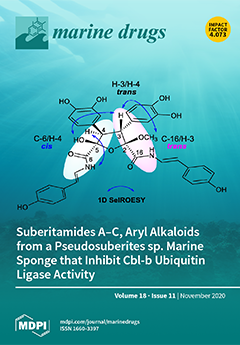One new meroterpenoid-type alkaloid, oxalicine C (
1), and two new erythritol derivatives, penicierythritols A (
6) and B (
7), together with four known meroterpenoids (
2–
5), were isolated from the marine algal-derived endophytic fungus
Penicillium
[...] Read more.
One new meroterpenoid-type alkaloid, oxalicine C (
1), and two new erythritol derivatives, penicierythritols A (
6) and B (
7), together with four known meroterpenoids (
2–
5), were isolated from the marine algal-derived endophytic fungus
Penicillium chrysogenum XNM-12. Their planar structures were determined by means of spectroscopic analyses, including UV, 1D and 2D NMR, and HRESIMS spectra. Their stereochemical configurations were established by comparing the experimental and calculated electronic circular dichroism (ECD) spectra for compound
1, as well as by comparison of the optical rotations with literature data for compounds
6 and
7. Notably, oxalicine C (
1) represents the first example of an oxalicine alkaloid with a cleaved α-pyrone ring, whereas penicierythritols A (
6) and B (
7) are the first reported from the
Penicillium species. The antimicrobial activities of compounds
1–
7 were evaluated. Compounds
1 and
6 exhibited moderate antibacterial effects against the plant pathogen
Ralstonia solanacearum with minimum inhibitory concentration (MIC) values of 8 and 4 μg/mL, respectively. Compound
6 also possesses moderate antifungal properties against the plant pathogen
Alternaria alternata with a MIC value of 8 μg/mL.
Full article






